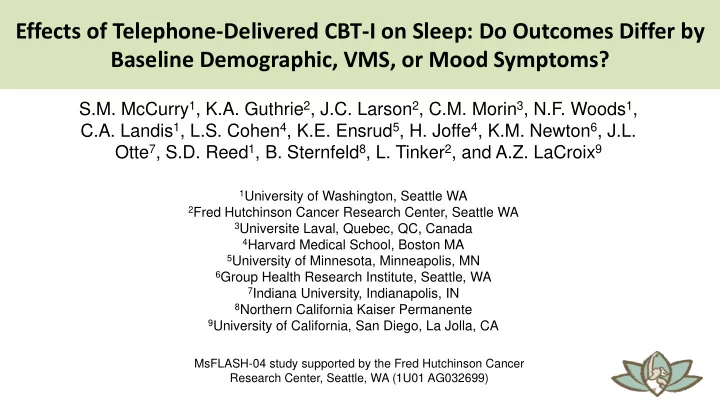

Effects of Telephone-Delivered CBT-I on Sleep: Do Outcomes Differ by Baseline Demographic, VMS, or Mood Symptoms? S.M. McCurry 1 , K.A. Guthrie 2 , J.C. Larson 2 , C.M. Morin 3 , N.F. Woods 1 , C.A. Landis 1 , L.S. Cohen 4 , K.E. Ensrud 5 , H. Joffe 4 , K.M. Newton 6 , J.L. Otte 7 , S.D. Reed 1 , B. Sternfeld 8 , L. Tinker 2 , and A.Z. LaCroix 9 1 University of Washington, Seattle WA 2 Fred Hutchinson Cancer Research Center, Seattle WA 3 Universite Laval, Quebec, QC, Canada 4 Harvard Medical School, Boston MA 5 University of Minnesota, Minneapolis, MN 6 Group Health Research Institute, Seattle, WA 7 Indiana University, Indianapolis, IN 8 Northern California Kaiser Permanente 9 University of California, San Diego, La Jolla, CA MsFLASH-04 study supported by the Fred Hutchinson Cancer Research Center, Seattle, WA (1U01 AG032699)
Significance • All women go through menopause; a majority also experience insomnia symptoms during this time of life • Menopause-related sleep disturbance places substantial economic burden on women and society • Sleep problems are a leading reason for visits to health care professionals during menopause • Effective, cost-efficient, non-pharmacological treatments are needed that can be integrated into primary care
Background: MsFLASH 04 Trial We have shown that telephone-delivered Cognitive Behavior Therapy for Insomnia (CBT-I) in peri- and post-menopausal women: • Is feasible • Is efficacious at 8 and 24-weeks for reducing self-reported insomnia symptoms, improving overall sleep quality, and increasing sleep efficiency compared to a Menopause Education Control (MEC) condition • Significantly reduced self-reported hot flash interference, depression symptoms, and stress compared to MEC Little is known about the interaction between sleep outcomes and baseline demographic, VMS, and mood variables
Intervention
Eligibility Inclusion: 40-65 years old, in the menopausal transition or Age/menopause postmenopausal ISI >12 (the observed median in other MsFLASH trials) Sleep > 2 hot flashes per day on average over 2 weeks by a daily diary Hot Flashes Available by telephone during the 8-week intervention Accessibility Written informed consent signed Consent Menstruated in past 60 days or < 2 skipped cycles Exclusion: Excessive use of alcohol (> 3 drinks/day) Previous diagnosis of primary sleep disorder (sleep apnea, restless legs syndrome, PLMS, REM behavior disorder, narcolepsy) Significant current major illness interfering with sleep or intervention participation (e.g., active cancer) Routine use (4+ days/week) of sedating prescription medications
RCT: Mean ISI Scores with 95% CI by Intervention Status and Time Point Mean (95% CI) baseline-week 24 change scores CBTI (n=44) MEC (n=37) Difference ISI -10.7 (-11.9, -9.4) -6.7 (-8.4, -5.0) -4.0 (-7.2, -3.5) P < .001
RCT: Mean PSQI Scores with 95% CI by Intervention Status and Time Point Mean (95% CI) baseline-week 24 change scores CBTI (n=44) MEC (n=37) Difference PSQI -4.3 (-5.1, -3.5) -2.7 (-3.5, -1.9) -1.6 (-2.7, -0.4) P < .002
Specific Aims of Current Study To evaluate whether the efficacy of CBT-I versus MEC for sleep varies by the presence of specific demographic characteristics and co-occurring menopausal symptoms measured at baseline. Sleep outcomes: Insomnia Severity Index (ISI), Pittsburgh Sleep Quality Index (PSQI) Exploratory hypothesis: Response to treatment in general, and to specific interventions will vary according to baseline: a) Demographics (age, education, marital status, menopausal status, duration of sleep disturbances, alcohol and sleep medication use, Berlin sleep apnea score) b) Vasomotor symptoms (# hot flashes/day, VMS bother) c) Mood (depression, PHQ-8; perceived stress, PSS)
Baseline Demographic Subgroups By Treatment Arm* CBTI (%) MEC (%) Age (> 55 years) 55 49 Education: College graduate 77 77 Married / Marriage like relationship 83 74 Alcohol use > 1 drink/day 64 60 Sleep medication use 49 32 Berlin sleep apnea, > 2 pos categories 38 25 Menopause status Postmenopausal 64 64 Perimenopausal / Indeterminate 36 36 Duration of sleep disturbances < 1 year 17 19 1 - < 5 years 53 38 > 5 years 28 42 * No significant differences by treatment arm
Baseline Symptom Subgroups by Treatment Arm* CBTI (%) MEC (%) VMS Frequency, HF / day < 4.8 36 32 4.8 - < 8.9 36 30 > 8.9 28 38 VMS Bother, 1 – 4 scale < 2.46 34 32 2.46 - < 2.87 36 30 > 2.87 30 38 PHQ-8 Depression < 10 70 68 > 10 28 30 Perceived Stress Scale (PSS) * No significant < 13 32 32 differences by treatment arm 13 – 17 39 26 > 18 36 40
Moderator Subgroup Analysis Plan • Between-group baseline characteristics were compared using chi-square tests. • Outcome analyses were based on intention to treat (ITT), including all randomized participants with follow-up data. • Tests for significant statistical interactions between treatment groups and each covariate to assess differential treatment responses were done via linear regression models, separately for 8- and 24-week outcomes.
8-week Treatment Interactions with Depression and Stress
Conclusions • Other than depression and stress, no baseline characteristic, including VMS frequency and bother, was significantly associated with sleep treatment response at either 8- or 24 weeks. • Observed depression and stress interaction effects were not maintained at 24 weeks but despite sustained improvements in insomnia symptoms and sleep quality. • Results support further development and testing of centralized CBT-I programs for treating menopausal insomnia.
Recommend
More recommend